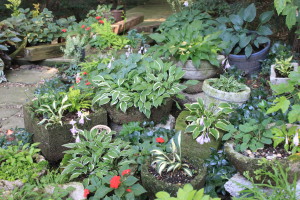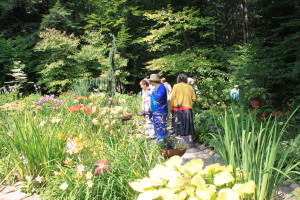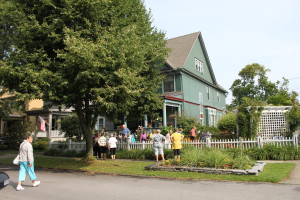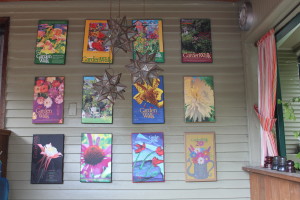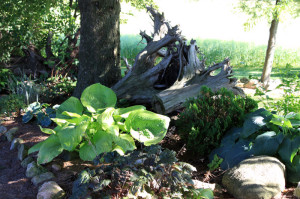It’s Still Just Dirt, The Tillsonburg News – November 2014
by Penny Esseltine
Christmasfest in Tillsonburg launched this past week so we know it’s not too soon to offer up some great gift ideas for gardeners. Chances are the gardeners on your list will love these suggestions, fresh from Tillsonburg Horticultural Society members. Gardening gifts at Christmas are a great way to stretch out the fall gardening season, or to take a leap ahead toward gardening in the spring.
Benoit Janssens tells us that last Christmas his son gave him an Accu-Rite Digital Weather Station that he totally enjoys. Ben says it consists of two parts. The sensor hangs outside and the receiver screen can be placed wherever you like – on a desk or mounted on a wall. The weather station tells you the temperature, relative humidity, and barometric pressure at 6, 12, and 24 hour intervals. “It’s not a real gardening gift,” Ben says, “but it certainly helps with planning gardening activities.”
Jan Torrell says that the one thing that was very pleasant to receive from her hubby for Christmas was a collapsible bag that you can take into the garden. “As you trim or remove dead plants, or even deadhead or weed, you can throw everything into the bag to take to the compost pile. When you are through, the bag collapses down to almost nothing and will hang on a hook or a nail in the shed.” Jan says there are several sizes and she has received two different ones. “The largest one,” she says,”is too big for me to handle when it’s full so Al has to help in the garden as well, which is an added bonus!”
You may have seen these bags in the window at Sinden’s Paint & Paper store not so long ago. Drew says he still has a dozen or so and they sell for $12.99.
“My most favourite gardening gift is a pair of rose gloves,” says Christine Nagy. “They were given to me at least 10 years ago and they are still going strong.” The gloves are gauntlet style, in a supple leather and the hand of the glove is quite fitted which allows for greater dexterity. The gloves extend almost to the elbow so they protect most of the arm. “These are great for any prickly pruning jobs and since I just use them for this task they are lasting a long time.” Christine says she can’t remember where her friend purchased them but you can find them at www.bionicgloves.com.
Mignonne Trepanier remembers a year when her youngest daughter Renee purchased two plate dahlia tubers for her through one of the garden catalogues. “She included pictures of them in her gift card.” One was two colours of pink, a lighter and a darker shade, and the petals of the second were coloured white at the base and then a hot pink at the tips. “They were delivered in the spring,” Mignonne says, “and I planted them. By the end of the season they had grown taller than me. They were spectacular.”
Joan Massicotte says the best garden gift she ever received was a gift certificate for a massage, to be used after that first full day of gardening in the spring.
For the budget conscious gift giver or for one who likes to give hand-made items, Monique Booth suggest “collecting the seeds from your annuals and putting them in special envelopes or labelled containers. Pass them on to family and friends who love to garden along with a picture or planting instructions.”
Here, in shorter form, are some additional suggestions well worth considering.
- Carol Acre says unique garden art objects, or solar lighting to show off the garden in the evening make great gardening gifts.
- Catherine Burke suggests that for aging parents, a gift of garden or lawn care services would be much appreciated. “For stocking stuffers perhaps some twine, fertilizer, or garden label stakes.”
- Marian Smith recommends gift certificates for your gardener’s favourite garden centre.
- Judi Misener suggests a subscription to Canadian Gardening magazine. “It would last all year long and it’s full of tips and advice and do-it-yourself information.” For eight issues the cost is $20.95 per year. Visit canadiangardening.com.
- Lastly there is Lee Valley, which a number of our members have recommended, for gift certificates, or for in-store or on-line shopping (www.leevalley.com). Lee Valley has a solid reputation for its wonderful selection of quality gardening items including tools and gifts.
My best garden gift idea was a lovely hexagon-shaped, hand-crafted pottery garden stone like the one I picked up at Don Zver Pottery in Troy. It reads, “Life without gardening? I don’t think so!” Sadly they have sold this year’s supply, but promise to produce more in the spring.
Don’t forget as well that you can stuff gardeners stockings with a 2015 membership to the Tillsonburg Horticultural Society. This costs $15. With this membership you can attend all of our monthly meetings and learn a lot from our speakers and other members of the group. There are great gardening trips that you can sign up for, and often you will receive a discount at local garden centres when you show your membership card. For information about memberships check out our website at tillsonburghorticultural.ca and look under About Us. You can contact us too at tillsonburghorticultural@live.ca.
